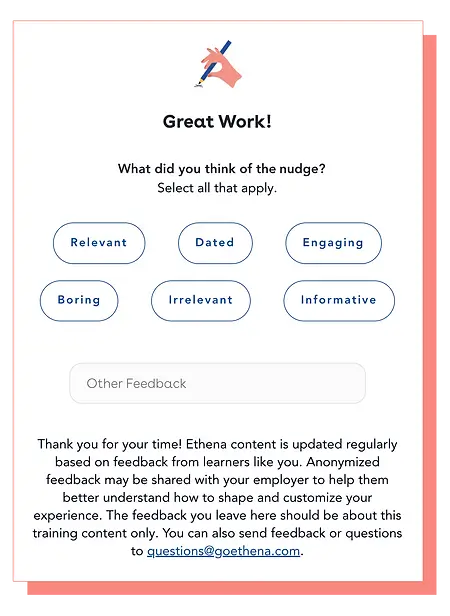Our (evolving) approach to asking for feedback from our customers
When I joined Ethena, I was amazed at how seriously our team takes feedback. Feedback is everywhere at Ethena—look no further than our teams’ calendars. You’ll see the end of the week sprinkled with 30-minute holds for “Feedback Fridays,” where managers and reports, as well as peers who work closely together, take a structured approach to giving each other praise and constructive criticism. These sessions happen every week like clockwork, meaning that across all of Ethena, feedback is a habit, not a one-off.
It’s also something that’s deeply ingrained in our product. Every Ethena training nudge ends with a slide where learners can provide their thoughts on training, and our content team reviews every single piece of feedback that comes through (yes, really!) and uses it to continuously make edits to create better learner experiences.

In my world, Customer Success, feedback plays a key role as well. A CS team’s purpose is to ensure customers are achieving value through our solution, and the only way to know whether that value is being achieved (or that we need to take corrective steps when it isn’t) is to get feedback from our customers.
CS at Ethena is no different, and as a new leader on the team, I needed to learn: what were we getting right and could build on to multiply value, and where were we missing the mark? Inspired by Ethena’s own culture, I set out to find out. Here are some of the things I’ve learned along the way about how to create a great feedback experience for everyone involved, from product teams to customers:
Have Authentic Conversations, but Be Methodical
Unsurprisingly, one of my first steps was to introduce myself and get to know as many customers as possible. I scheduled a number of introductory calls, and at first I kept my planning casual, working off a rough outline of questions and relying on the flow of conversation to learn about customers’ Ethena experience so far. These discussions were helpful, but they lacked the continuity I needed to really turn them into actionable themes because I was focusing on slightly different topics with each customer I spoke to. A mentor of mine challenged me to turn that rough discussion outline into a focused template with incredibly specific questions that every customer conversation needed to cover.
I immediately saw a difference in my ability to capture useful feedback from these calls. While being careful to ensure that they were still discussions, rather than “live questionnaires,” I was disciplined in making sure I asked the same questions in the same ways to each customer, and I immediately started to see patterns in what customers’ priorities were and how we could better support them. I went from having a grab bag of feedback nuggets to a clear set of patterns and takeaways.
Be Human, Even Via Email
Check your inbox right now—you’ve probably got at least one message in there asking you to fill out a customer satisfaction survey. Most of us click the trash can icon without a second thought, and as a result, the average response rates for these types of emails tend to hover in the single digits.
Why, though? If we break this email down, it’s a message that’s being sent from someone who has influence over a product or service we use. They’re asking for our thoughts and opinions so they can ultimately help us out. Customers won’t necessarily see the improvements they request tomorrow, but answering the survey helps put that work in motion. With Ethena’s first customer feedback survey, I focused on keeping this top of mind for our customers. I skipped the boilerplate “Your feedback will help us improve our products and services,” and opted for more personal language recalling for customers the built-in feedback mechanisms in our product and the ways we use them for continuous improvement. To double down on putting real action behind our ask, I reached out personally to customers to further explain the survey, letting them know that I could act as an immediate resource to them, while filling out our feedback survey would support longer-term improvements.
This led to us receiving many responses from customers and taking away actionable feedback that has directly influenced what features and resources we plan to build this year.
The Right Mechanism for the Right Moment
There are a handful of tried and true customer feedback survey approaches, including CES, CSAT, and NPS (the list of acronyms goes on). These frameworks and the defined sets of questions they incorporate are industry standards for a reason: when used correctly, they can provide actionable insights about key areas of customer sentiment. The problem is that so often, the wrong method is applied, leaving a confusing experience for the customer and unhelpful, murky data for the product team.
I experienced this myself recently. I had just called into the customer support line for a subscription service I use. The call went great—my issue was fully resolved, and the rep I spoke with was concise, clear, and fun to talk to. Eager to share thoughts on my experience, I waited for the feedback survey email to come through. When I opened the message, I saw a standard NPS question: “On a scale of 0-10, how likely are you to recommend our products and services to a friend or colleague?” This left me kind of stuck. A problem with the product was what had led me to call into the support line, so I wasn’t really feeling a “10” on that front, but I’d had a top-notch phone call with the rep and wanted to make sure I could give that specific experience top marks. I was left not knowing how to answer the question, and I can imagine the person on the receiving end of my answer would struggle to understand my intent as well.
To avoid situations like this, our team thinks critically about both who to ask for feedback and how to structure questions so that customers can easily provide clear answers and we can confidently take action in response. As an example, for the customer survey I referenced above, I intentionally chose to use the product-market fit survey framework as a baseline for our questionnaire (here’s a great primer on the product-market fit methodology if you’re interested). This approach allowed us not only to assess the satisfaction of our admin user group, but also to understand what specific aspects of our product and experience are difference-makers for them and which aspects are in need of improvement. As we considered our short- and long-term product roadmap and customer experience priorities, this information was exactly what we needed at this moment in time to make better decisions and plans.
At Ethena, where feedback is baked into the culture from internal meetings to nearly every aspect of our live product, everyone on our team is interested in making sure the customer’s voice is heard and considered carefully. Our admins and learners are behind every evolution of Ethena’s platform, training materials, and yes, even our feedback forms!
So with that, do you have any feedback for me? Let me know at [email protected]. And if you’re interested in learning more about our growing Customer Success team at Ethena, we’re hiring!








